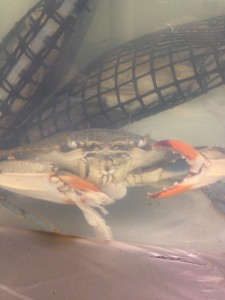Who We Are
What We Did
For our research we first needed crabs. Kelly purchased a set of crabs that we worked with, however, these crabs were unfit. They demonstrated unusual behavior, died off quickly, and ultimately we had to throw that set of information out.
So, we went crabbing for the second batch of crabs at Packery Channel. We first prepared the bait which consists of string tied to a ruler and chicken at the other end. We set up tanks which consist of filters and shells. We also had incubators to hold the crabs when crabbing. During a a full day of crabbing we successfully caught many crabs that met our needs (about 2 inches).
We next separated the crabs in to groups: Control group which received no pesticide, exposed group which received doses of pesticide, and an acute group which received a small dose of pesticide.
Throughout the process we had to continually maintain healthy crabs by proper care. Tanks had to be cleaned, filters needed to continually be checked and cleaned, and the right type of water needed to be used.
Kelly’s research consisted of documenting how the pesticide affects the crabs over a period of time because crabs are being exposed to this in their natural environment. She did this by comparing a variety of characteristics from each group. She would flip the crabs in increments of 8 or 12 hours and document the following:
– Strategy: Type of behavior crab exhibits
– Consistency Response Ordinal: Duration/Consistency of response
– Eye Stalk Retraction: Eye reflex
– Time to Flip: The amount of time it takes for the crab to turn back upright
– Notes: Any note-worthy behavior the crab exhibits
What We Learned
We learned that the pesticide does affect the behavior of crabs. The crabs exposed had reduced natural crab characteristics.
Since a lot of my time was with the first batch of crabs (where the research was non reliable) I learned the difference between a healthy and ill crab.
Healthy crabs are quick to flip back, active, and are quick to pinch at whatever threat nears them. On the contrary, ill crabs are slow moving. not affected as quickly by danger, and are slow to retract their eyes.
Questions We Have
Would crabs eventually develop a resistance to the pesticide if their environment continues to carry it for a long period of time?
Does the stress of being in small tanks affect their behavior instead of just the pesticide?
Connections to Teaching
5th Grade Science:
(2) Scientific investigation and reasoning. The student uses scientific methods during laboratory and outdoor investigations. The student is expected to:
(A) describe, plan, and implement simple experimental investigations testing one variable;
(B) ask well-defined questions, formulate testable hypotheses, and select and use appropriate equipment and technology;
(C) collect information by detailed observations and accurate measuring;
(D) analyze and interpret information to construct reasonable explanations from direct (observable) and indirect (inferred) evidence;
(E) demonstrate that repeated investigations may increase the reliability of results;
(F) communicate valid conclusions in both written and verbal forms; and
(G) construct appropriate simple graphs, tables, maps, and charts using technology, including computers, to organize, examine, and evaluate information.
